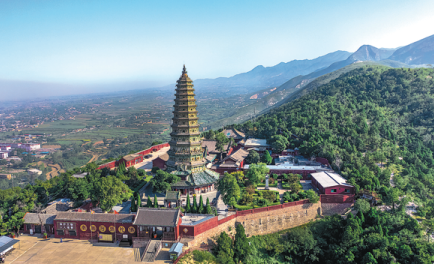Guangsheng Temple among 'hidden gems'

The pagoda in Guangsheng Temple is the tallest multicolored glazed pagoda in the world. [Photo by Chang Puping for China Daily]
As a cradle of Chinese culture, Shanxi is said to be a province containing one of the greatest numbers of cultural and historical resources.
While some landmark historical relics and monuments such as the Great Wall that spans the province, the Yungang Grottoes in Datong and the Sakyamuni Pagoda in Yingxian, top tourists' itineraries, some "hidden gems"-places of historical interest with less fame-are also worth visiting.
The Guangsheng Buddhist Temple in Zhaocheng township in Hongtong county, for instance, is one such hidden gem.
Guangsheng is actually a temple complex consisting of the upper monastery, the lower monastery and the Water God Temple on the slope and at foot of the Huoshan Mountain in Zhaocheng.
Construction of the Guangsheng Temple is said to have begun more than 1,800 years ago during the Eastern Han Dynasty (25-220), making it among the earliest Buddhist temples in China.
The temple was reconstructed several times after facing destruction by wars and natural disasters during various historical periods. Most of the structures and relics we can see now were built and created during the Yuan (1271-1368) and Ming (1368-1644) dynasties.
Tourists to Guangsheng should not miss the "three treasures" of the temple: the glazed pagoda, the Buddhist sutras called Zhaocheng's Collection and its murals.
Located in the upper monastery, the glazed pagoda is a 13-story, 47.31-meter-tall octagonal pyramid-shaped tower. Written records show this pagoda was built in 1527 during the Ming Dynasty.
As the multicolored glazed walls and roofs can sometimes turn the sunlight into colorful, rainbow-like reflections, the structure is also called Feihongta, or Flying Rainbow Pagoda.
On the outer walls and roofs, there are many glazed ornamental pieces featuring figures of humans, auspicious animals and small statues of Buddhas, bodhisattvas and monks. Inside the pagoda's foundation hall is a 5-meter-tall bronze statue of Sakyamuni Buddha.
Since its construction in 1527, the pagoda has survived two severe earthquakes that measured above 8.0 on the Richter scale.
On Aug 29, 2018, London-based World Record Certification recognized it as "the tallest multicolored glazed pagoda in the world".
The Zhaocheng's Collection of Buddhist sutras in the temple is among the most precious Buddhist sutra copies in China. It was printed during the Yuan Dynasty and it took 24 years for a great number of monks and craftsmen to engrave woodblocks for printing.
There are several precious Yuan Dynasty murals in the temple complex, including the paintings on the four walls of the Water God Temple and the painting on the gable wall in front of the Great Hall of Sakyamuni Buddha in the lower monastery.
Researchers said these paintings are of great significance to research as they represented the artistic style and depicted the life of the Yuan Dynasty.
Unfortunately, some of the largest sections of the murals, which used to be in the Great Hall of Sakyamuni Buddha, were stolen in 1928 and smuggled overseas in the years that followed.
Zhang Zhigang contributed to this story.



